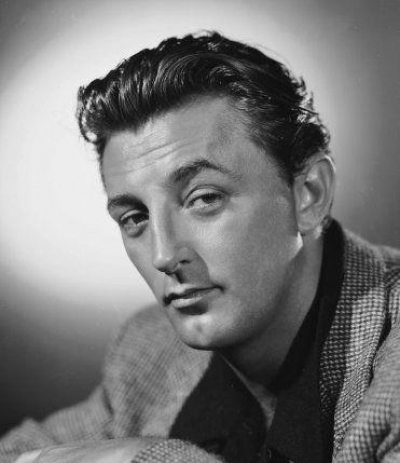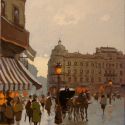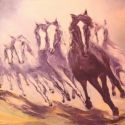
photo:
http://titian.altervista.org/importD50.jpg
Biography
Early life and career
Robert Mitchum was born in Bridgeport, Connecticut on August 6, 1917 to shipyard and railroad worker James Thomas Mitchum and Ann Gunderson Mitchum, a Norwegian immigrant and sea captain's daughter. His father was a former soldier and known barroom brawler of Scots-Irish ancestry (on his father's side) and Blackfoot descent (on his mother's side). James Mitchum was crushed to death in a shipyard accident when Mitchum was eighteen months old, leaving Ann to find work as a linotype operator at a newspaper.
Throughout Robert's childhood, he was known as a prankster, often involved in fistfights and pranks. When he was 12, Ann sent Robert to live with his grandparents in Felton, Delaware, where he was promptly expelled from his middle school for scuffling with a principal. A year later, in 1930, he moved in with his older sister, waitress and stage actress Julie (originally Annette) Mitchum, in New York's Hell's Kitchen. After being expelled from Haaran High School, he left his sister and traveled throughout the country on railroad cars, taking a number of jobs including a ditch-digger for the Civilian Conservation Corps and a professional boxer. He experienced numerous adventures during his years as one of the Depression era's "wild boys of the road." In Savannah, Georgia he was arrested for vagrancy and put on a local chain gang. By Mitchum's own account he escaped and returned to his family in Delaware. It was during this time, while recovering from injuries that nearly lost him a leg, that he met the woman he would marry, a teenaged Dorothy Spence. He soon went back on the road, eventually riding the rails to California.
Mitchum arrived in Long Beach, California in 1936, staying again with his sister Julie. Soon the rest of the Mitchum family joined them in Long Beach. It was sister Julie who convinced Robert to join the local theater guild with her. In his years with the Players Guild of Long Beach, he made a living as a stagehand and occasional bit player in plays. He also wrote several short pieces which were performed by the guild. According to Lee Server's biography (Robert Mitchum: Baby, I Don't Care), Mitchum put a talent for poetry to work writing song lyrics and monologues for his sister Julie's nightclub performances. In 1940 he returned East to marry Dorothy, taking her back to California. He remained a footloose character until the birth of their first child, Jim, nicknamed Josh (two more children would follow, Christopher and Petrine). Robert then got a steady job as a machine operator with the Lockheed Aircraft Corporation . An apparent nervous breakdown from this encounter with conformity led him to look for work as an actor or extra in movies. An agent he had met got him an interview with the producer of the Hopalong Cassidy series of B-westerns and he was hired to play the villain in several films in the series between 1942 and 1943. He continued to find further as an extra and supporting actor in numerous productions for various studios. After impressing director Mervyn LeRoy during the making of Thirty Seconds Over Tokyo, Mitchum signed a seven year contract with RKO Radio Pictures. He found himself groomed for B Western stardom in a series of Zane Grey adaptations.
Following the moderately successful western Nevada, Mitchum was loaned out from RKO to United Artists for the William Wellman-helmed The Story of G.I. Joe. In the film, he portrayed war-weary officer Bill Walker, who remains resolute despite the troubles he faces. The film, which followed the life of an ordinary soldier through the eyes of journalist Ernie Pyle (played by Burgess Meredith, became an instant critical and commercial success. At the 1946 Academy Awards, the film was nominated for four Oscars, including Mitchum's only nomination for Best Supporting Actor. He finished the year off with a western (West of the Pecos) and another war film (Till the End of Time), before transitioning into a genre that came to define both Mitchum's career and screen persona: film noir.
Work in film noir
Mitchum would become the signature actor in the genre known as film noir. His first entry into this world of dark crime stories was the well regarded B-movie, When Strangers Marry, about a psychotic serial killer. One of Mitchum's early film noir outings, Undercurrent, featured him playing against type as a troubled, sensitive man entangled in the affairs his brother (Robert Taylor) and his brother's suspicious wife (Katharine Hepburn). The ill-received film was Vincente Minnelli's first and last film noir as director. John Brahm's The Locket (1946) featured Mitchum as a bitter ex-husband of Laraine Day's femme fatale, while the Raoul Walsh-helmed Pursued (1947) combined the western and film noir genres, with Mitchum's character trying to remember his past and find those responsible for killing his family. Crossfire, also released in 1947 featured Mitchum as a member of a group of soldiers who killed a Jew and featured themes of anti-semitism and the failings of military training. The film, directed by Edward Dmytryk, was one of most critically acclaimed of the year garnering five Academy Award nominations.
Following Crossfire, Robert Mitchum starred in what was arguably the most defining film of his career. Out of the Past directed by Jacques Tourneur and benefiting from the cinematography of Nicholas Musuraca starred Mitchum as Jeff Markham, a small-town gas station employee who must face the problems through gambler Whit Sterling (Kirk Douglas). In addition to featuring one of the most potent anti-heroes in film history, played by Mitchum, also had one of the best remembered femme fatales, played by Jane Greer. Though the film was ignored by most critics upon its release, the film was a modest box office hit and has gained critical praise by both film journalists and filmmakers themselves in the decades since its release. Mitchum was photographed again by Musuraca in the Robert Wise "psychological western" Blood on the Moon the following year.
Mitchum's cynical, mischievous attitude continued through adulthood and led him to shrug off fame as a fluke. On set he often played pranks on fellow actors and crew. His expulsion from 1955's Blood Alley is frequently attributed to his pranks, especially one in which he reportedly threw the film's transportation manager into San Francisco Bay. In August 1948, after a string of successful films for RKO, he was arrested by narcotics officers for marijuana possession and sentenced to 60 days at a Castaic, California prison farm. The accident did little to effect his career in the long term, but was seen as an embarrassment by his studio, who ordered Mitchum to clean up his act. The conviction was later overturned by the Los Angeles court and District Attorney's office on January 31, 1951 with the following statement, after it was exposed as a set-up.
"After an exhaustive investigation of the evidence and testimony presented at the trial, the court orders that the verdict of guilty be set aside and that a plea of not guilty be entered and that the information or complaint be dismissed."
Despite troubles with the law and his studio, the films released immediately after his arrest were box-office hits. Rachel and the Stranger (1948) featured Mitchum in a supporting role as a mountain man interested in gaining the hand of Loretta Young, the indentured servant and wife of William Holden, while the John Steinbeck adaptation The Red Pony as a trusted cowhand to a ranching family.
Robert Mitchum returned to true film noir in 1949's The Big Steal, pairing Mitchum and Jane Greer once again in an early Don Siegel film. The Racket was a noir remake of the early crime drama The Racket and featured Mitchum as a police captain fighting corruption in his precinct. The Josef von Sternberg film Macao (1952) saw Mitchum a victim of mistaken identity at an exotic resort casino. Otto Preminger's Angel Face saw the first of three collaborations between Mitchum and British stage actress Jean Simmons. In the film, Simmons plays an insane heiress who plans to use young ambulance driver Mitchum to kill for her.
Career in the '50s and '60s
Though Mitchum would continue to star in a number of crime dramas, some classified within the film noir genre, 1955 marked his last true noir outing and his first film as a freelance actor, the Charles Laughton helmed Night of the Hunter. Following a series of conventional westerns and films noir, including the Marilyn Monroe vehicle River of No Return (1954), The Night of the Hunter would become one of the landmark films of the decade. Based on a novel by Davis Grubb, the film noir thriller starred Mitchum as a psychotic criminal posing as a preacher to find money hidden by his cellmate in the cellmate's home. The film remains one of the most chilling and suspenseful thrillers of the decade, though it was a critical and commercial failure upon its first release. While The Night of the Hunter was a box office flop which went on to become critically acclaimed decades afterward, Stanley Kramer's melodrama Not as a Stranger, also released in 1955, was box office hit for Mitchum, which has been largely forgotten today. The film starred Mitchum against type, as an idealistic young doctor, who marries a wealthy woman (Olivia de Havilland), only to question his morality many years later.
Following a succession of average westerns and the poorly received Foreign Intrigue (1956), Mitchum starred in the first of three screen collaborations with British actress Deborah Kerr. The intriguing John Huston war drama Heaven Knows, Mr. Allison starred Mitchum as a marine corporal shipwrecked on a Pacific Island only to discover his sole companion is a nun, Sister Angela (Deborah Kerr). The character study centers on the relationship between the two as they fight for survival from the elements and the invading Japanese army. The film was nominated for two Academy Awards, including Best Actress and Best Adapted Screenplay. For his role, Mitchum was nominated for a BAFTA Award for Best Foreign Actor. Mitchum and Kerr were paired again in 1960, first for the critically acclaimed Fred Zinnemann film, The Sundowners, where they played husband and wife struggling in Depression-era Australia. Opposite Mitchum, Kerr was nominated for yet another Academy Award for Best Actress, while the film was nominated for a total of five Oscars. Robert Mitchum was awarded that year's National Board of Review award for Best Actor for his performance. The award also recognized his superior performance in the Vincente Minnelli western drama Home from the Hill. He was teamed with both Kerr and previous leading lady Jean Simmons for the Stanley Donen ensemble comedy The Grass Is Greener the same year.
Mitchum's performance as the menacing southern rapist Max Cady in 1962's Cape Fear brought him even more attention and furthered his renown as playing cool, predatory characters. The 1960s were marked by a number of lesser films and missed opportunities. Among the films Mitchum passed on during the decade was John Huston's The Misfits, the last film of its stars Clark Gable and Marilyn Monroe, the Academy Award-winning Patton and Clint Eastwood's breakthrough film Dirty Harry. The most notable of his films later in the decade included the war epics The Longest Day (1962) and Anzio (1968), the Shirley MacLaine comedy-musical What a Way to Go! (1964), and the Howard Hawks western El Dorado (1966).
Music career
One of the lesser known aspects of Robert Mitchum's career was his forays into music. His voice had long been used instead of the professional singers when characters portrayed by Mitchum sang in his films. Notable productions featuring Mitchum's own singing voice included Rachel and the Stranger (1948), River of No Return (1954) and The Night of the Hunter (1955). After hearing traditional calypso music and meeting artists such as Mighty Sparrow and Lord Invader while filming Heaven Knows, Mr. Allison in the Caribbean island of Tobago, he recorded Calypso — Is Like So . . . in March of 1957. On the album, released through Capitol Records, he emulated the calypso sound and style, even adopting the style's unique pronunciations and slang. A year later he recorded a song he had written for the film Thunder Road, titled "The Ballad of Thunder Road." The country-styled song became a modest hit for Mitchum, reaching #69 on the Billboard Pop Singles Chart. The song was included as a bonus track on a successful reissue of Calypso. . . and helped market the film to a wider audience.
Though Mitchum continued to use his singing voice in his film work, he waited until 1967 to record his follow-up record, That Man, Robert Mitchum, Sings. The album, released by Nashville-based Monument Records, took him further into country music, and featured songs similar to The Ballad of Thunder Road. "Little Old Wine Drinker Me," the first single, was a top ten hit at country radio, reaching #9 there, and crossed over onto mainstream radio, where it peaked at #96. Its follow-up, "You Deserve Each Other," also charted on the Billboard Country Singles Chart.
Later career and death
Robert Mitchum made a departure from his typical screen persona with the David Lean classic Ryan's Daughter in 1970. In the critically acclaimed film, he starred as Charles Shaughnessy, a mild-mannered schoolmaster in World War I era Ireland. Though the film was nominated for four Academy Awards (winning two) and Mitchum was much publicized as a contender for a Best Actor nomination, he was passed over. George C. Scott won the award for his performance in Patton, a project which Mitchum had passed over for Ryan's Daughter.
The 1970s, however, saw Mitchum in a number of well-received crime dramas. The Friends of Eddie Coyle (1973) saw the actor playing an aging hoodlum caught between the Feds and his criminal friends. Sydney Pollack's The Yakuza (1975) supplanted the typical film noir story arch in the Japanese underworld. Mitchum's stint as an aging Philip Marlowe in the Raymond Chandler adaptation, Farewell, My Lovely (1975), was well-received by audiences and critics. Reprising the role three years later in The Big Sleep proved a mistake, however, as Michael Winner took the film at once closer to the source material and farther away from its spirit and context, setting the film in modern day London.
Robert Mitchum expanded into the medium of television with the 1983 miniseries The Winds of War. The big-budget Herman Wouk adaptation aired on ABC and starred Mitchum as "Pug" Henry, a naval officer and examined the events leading up to America's involvement in World War II. He followed it in 1988 with War and Remembrance, which followed America through the war. The same year, he returned to the screen for a memorable supporting role in the Bill Murray A Christmas Carol interpolation, Scrooged.
Though Mitchum continued to appear in films throughout the 1990s, such as Tombstone and Jim Jarmusch's Dead Man, the actor gradually slowed his workrate. His last film appearance was in the television biopic, James Dean: Race with Destiny. He died on July 1, 1997 in Santa Barbara, California due to complications of lung cancer and emphysema. He left his wife, Dorothy Mitchum, and actor son, Christopher Mitchum, and daughter Trini Mitchum behind. His grandchildren, Bentley Mitchum and Carrie Mitchum, are also actors. In 1991, he won a lifetime achievement award from the National Board of Review and the Cecil B. DeMille Award from the Golden Globe Awards in 1992. It had been widely predicted for at least a decade that his eventual death would spark a huge fascination with his film canon, but James Stewart died the very next day, immediately eclipsing Mitchum's death in the mainstream media.
Filmography
The Magic of Make-Up (1942) (documentary)
The Human Comedy (1943)
Hoppy Serves a Writ (1943)
Aerial Gunner (1943)
Border Patrol (1943)
Follow the Band (1943)
The Leather Burners (1943)
Colt Comrades (1943)
We've Never Been Licked (1943)
Lone Star Trail (1943)
Beyond the Last Frontier (1943)
Corvette K-225 (1943)
Bar 20 (1943)
Doughboys in Ireland (1943)
False Colors (1943)
Minesweeper (1943)
The Dancing Masters (1943)
Cry 'Havoc' (1943)
Riders of the Deadline (1943)
Gung Ho! (1943)
Johnny Doesn't Live Here Anymore (1944)
Mr. Winkle Goes to War (1944)
When Strangers Marry (1944)
Girl Rush (1944)
Thirty Seconds Over Tokyo (1944)
Nevada (1944)
The Story of G.I. Joe (1945)
West of the Pecos (1945)
Till the End of Time (1946)
Undercurrent (1946)
The Locket (1946)
Pursued (1947)
Crossfire (1947)
Desire Me (1947)
Out of the Past (1947)
Rachel and the Stranger (1948)
Blood on the Moon (1948)
The Red Pony (1949)
The Big Steal (1949)
Holiday Affair (1949)
Where Danger Lives (1950)
Hollywood Goes to Bat (1950) (short subject)
My Forbidden Past (1951)
His Kind of Woman (1951)
The Racket (1951)
Macao (1952)
One Minute to Zero (1952)
The Lusty Men (1952)
Angel Face (1952)
White Witch Doctor (1953)
Second Chance (1953)
She Couldn't Say No (1954)
River of No Return (1954)
Track of the Cat (1954)
Not as a Stranger (1955)
The Night of the Hunter (1955)
Man with the Gun (1955)
Foreign Intrigue (1956)
Bandido (1956)
Heaven Knows, Mr. Allison (1957)
Fire Down Below (1957)
The Enemy Below (1957)
Thunder Road (1958)
The Hunters (1958)
The Angry Hills (1959)
The Wonderful Country (1959)
Home from the Hill (1960)
A Terrible Beauty (1960)
The Sundowners (1960)
The Grass Is Greener (1960)
The Last Time I Saw Archie (1961)
Cape Fear (1962)
The Longest Day (1962)
Two for the Seesaw (1962)
The List of Adrian Messenger (1963) (Cameo)
Rampage (1963)
Man in the Middle (1964)
What a Way to Go! (1964)
Mister Moses (1965)
El Dorado (1966)
The Way West (1967)
Villa Rides (1968)
Anzio (1968)
5 Card Stud (1968)
Secret Ceremony (1968)
Young Billy Young (1969)
The Good Guys and the Bad Guys (1969)
Ryan's Daughter (1970)
Going Home (1971)
The Wrath of God (1972)
The Friends of Eddie Coyle (1973)
The Yakuza (1975)
Farewell, My Lovely (1975)
Midway (movie) (1976)
The Last Tycoon (1976)
The Amsterdam Kill (1977)
Matilda (1978)
The Big Sleep (1978)
Breakthrough (1979)
Agency (1980)
Nightkill (1980)
That Championship Season (1982)
The Winds of War (1983) (Miniseries)
The Ambassador (1984)
Maria's Lovers (1984)
North and South (1985) (Miniseries)
Remembering Marilyn (1987) (documentary)
Marilyn Monroe: Beyond the Legend (1987) (documentary)
Mr. North (1988)
War and Remembrance (1988) (Miniseries)
Scrooged (1988)
John Huston: The Man, the Movies, the Maverick (1989) (documentary)
Waiting for the Wind (1990) (short subject)
Believed Violent (1990)
Cape Fear (1991)
The Seven Deadly Sins (1992)
Woman of Desire (1993)
Tombstone (1993) (narrator)
Backfire! (1995)
Dead Man (1995)
Waiting for Sunset (1995)
Wild Bill: Hollywood Maverick (1996) (documentary)
James Dean: Race with Destiny (1997)
Discography
Albums
Calypso — Is Like So . . . (1957, Capitol)
That Man, Robert Mitchum, Sings (1967, Monument) Country: #35
Singles
"The Ballad of Thunder Road" (1958, Capitol) Pop: #62
"Little Old Wine Drinker Me" (1967, Monument) Country: #9 Pop: #96
"You Deserve Each Other" (1967, Monument) Country: #55
References and further reading
Lee Server (2001). Robert Mitchum: "Baby, I don't care", New York: St Martin's. ISBN 0-312-26206-X.
Mike TomkiesThe Robert Mitchum Story, "It Sure Beats Working" Ballantine Books, 1972, ISBN 345-23484-7-125

































